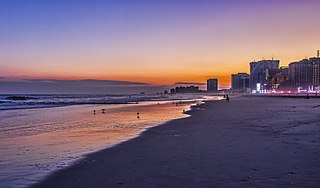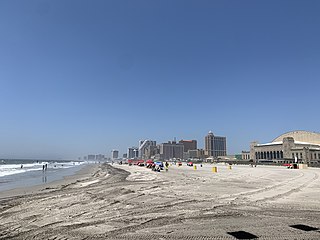
Atlantic City, sometimes referred to by its initials A.C., is a Jersey Shore seaside resort city in Atlantic County, in the U.S. state of New Jersey. Located in South Jersey on Absecon Island, the city is prominently known for its casinos, nightlife, boardwalk, and Atlantic Ocean beaches and coastline. Atlantic City inspired the U.S. version of the board game Monopoly, which uses various Atlantic City street names and destinations in the game. New Jersey voters legalized casino gambling in Atlantic City in 1976, and the first casino opened two years later. Atlantic City had been the home of the Miss America pageant from 1921 to 2004, which later returned to the city from 2013 to 2018.

The Cotton Club was a New York City nightclub from 1923 to 1940. It was located on 142nd Street and Lenox Avenue (1923–1936), then briefly in the midtown Theater District (1936–1940). The club operated during the United States' era of Prohibition and Jim Crow era racial segregation. Black people initially could not patronize the Cotton Club, but the venue featured many of the most popular black entertainers of the era, including musicians Fletcher Henderson, Duke Ellington, Jimmie Lunceford, Chick Webb, Louis Armstrong, Count Basie, Fats Waller, Willie Bryant; vocalists Adelaide Hall, Ethel Waters, Cab Calloway, Bessie Smith, Lillie Delk Christian, Aida Ward, Avon Long, the Dandridge Sisters, the Will Vodery choir, The Mills Brothers, Nina Mae McKinney, Billie Holiday, Midge Williams, Lena Horne, and dancers such as Katherine Dunham, Bill Robinson, The Nicholas Brothers, Charles 'Honi' Coles, Leonard Reed, Stepin Fetchit, the Berry Brothers, The Four Step Brothers, Jeni Le Gon and Earl Snakehips Tucker.

Uptown is one of Chicago's 77 community areas. Uptown's boundaries are Foster Avenue on the north; Lake Michigan on the east; Montrose Avenue, and Irving Park Road on the south; Ravenswood Avenue, and Clark Street on the west. To the north is Edgewater, to the west is Lincoln Square, and to the south is Lakeview. Near the lake are some of the northern reaches of Lincoln Park including Montrose Beach and a nature reserve. The area has a mix of commercial and residential development, and includes a well established entertainment district of clubs and concert venues, and was a center for early movie making. Truman College a two year city college is located here, and the area's south-western end includes the historic 19th century Graceland Cemetery.

Lenox Avenue – also named Malcolm X Boulevard; both names are officially recognized – is the primary north–south route through Harlem in the upper portion of the New York City borough of Manhattan. This two-way street runs from Farmers' Gate at Central Park North to 147th Street. Its traffic is figuratively described as "Harlem's heartbeat" by Langston Hughes in his poem Juke Box Love Song. The IRT Lenox Avenue Line runs under the entire length of the street, serving the New York City Subway's 2 and 3 trains.

South Philadelphia, nicknamed South Philly, is the section of Philadelphia bounded by South Street to the north, the Delaware River to the east and south, and the Schuylkill River to the west. A diverse working-class community of many neighborhoods, South Philadelphia is well-known for its large Italian-American population, but it also contains large Asian American, Irish-American, African-American, and Latino populations.

Central Avenue is a major north–south thoroughfare in the central portion of the Los Angeles, California metropolitan area. Located just to the west of the Alameda Corridor, it runs south from the eastern end of the Los Angeles Civic Center down to the east side of California State University, Dominguez Hills and terminating at East Del Amo Boulevard in Carson.

Five Points is one of Denver, Colorado's oldest neighborhoods. It is now one of the fastest growing in terms of both redevelopment and population. Much of this growth is taking place in the River North Arts District, or "RiNo", which is often considered by locals a neighborhood of its own; although it is officially within the Five Points neighborhood in addition to parts of neighboring Globeville and Elyria-Swansea.

Indiana Avenue is a historic area in downtown and is one of seven designated cultural districts in Indianapolis, Indiana. Indiana Avenue was, during its glory days, an African American cultural center of the area. The Indiana Avenue Historic District within the area was designated a United States national historic district in 1987.

The Harlem Renaissance was an intellectual and cultural revival of African American music, dance, art, fashion, literature, theater, politics and scholarship centered in Harlem, Manhattan, New York City, spanning the 1920s and 1930s. At the time, it was known as the "New Negro Movement", named after The New Negro, a 1925 anthology edited by Alain Locke. The movement also included the new African American cultural expressions across the urban areas in the Northeast and Midwest United States affected by a renewed militancy in the general struggle for civil rights, combined with the Great Migration of African American workers fleeing the racist conditions of the Jim Crow Deep South, as Harlem was the final destination of the largest number of those who migrated north.
Joseph Christopher Columbus Morris, better known as Crazy Chris Columbo or just Chris Columbo, was an American jazz drummer. He was sometimes credited as Joe Morris on record, though he is no relation to free jazz guitarist Joe Morris or trumpeter Joe Morris.

133rd Street is a street in Manhattan and the Bronx, New York City. In Harlem, Manhattan, it begins at Riverside Drive on its western side and crosses Broadway, Amsterdam Avenue, and ends at Convent Avenue, before resuming on the eastern side, crossing Seventh Avenue, and ending at Lenox Avenue. In Port Morris in the Bronx, it runs from Bruckner Boulevard/St. Ann's Place to Locust Avenue. The block between Seventh Avenue and Lenox Avenues was once a thriving night spot, known as "Swing Street", with numerous cabarets, jazz clubs, and speakeasies. The street is described in modern times as "a quiet stretch of brownstones and tenement-style apartment houses, the kind of block that typifies this section of central Harlem".
Leonard Harper was a producer, stager, and choreographer in New York City during the Harlem Renaissance in the 1920s and 1930s.

Missouri Avenue Beach, often referred to as "Chicken Bone Beach," was a racially segregated section of the Atlantic Ocean beach at Atlantic City, New Jersey . The name was initially most likely a pejorative reference to the packed lunches brought by beachgoers who were not permitted by unspoken sentiment in many dining establishments, but the Black community has reclaimed the name as a point of resistance and pride. The beach is now home to swimming, sunbathing, jazz and other local events.

The 500 Club, popularly known as The Five, was a nightclub and supper club at 6 Missouri Avenue in Atlantic City, New Jersey, United States. It was owned by racketeer Paul "Skinny" D'Amato, and operated from the 1930s until the building burned down in 1973.

Club Harlem was a nightclub at 32 Kentucky Avenue in Atlantic City, New Jersey. Founded in 1935 by Leroy "Pop" Williams, it was the city's premier club for black jazz performers. Like its Harlem counterpart, the Cotton Club, many of Club Harlem's guests were white, wealthy and eager to experience a night of African-American entertainment.
The Paradise Club or Club Paradise was a nightclub and jazz club at 220 North Illinois Avenue in Atlantic City, New Jersey. It was one of two major black jazz clubs in Atlantic City during its heyday from the 1920s through 1950s, the other being Club Harlem. Entertaining a predominantly white clientele, it was known for its raucous floor shows featuring gyrating black dancers accompanied by high-energy jazz bands led by the likes of Count Basie, Jimmie Lunceford, and Lucky Millinder. In 1954 the Paradise Club merged with Club Harlem under joint ownership.

Grace's Little Belmont was a jazz music bar and lounge in Atlantic City, New Jersey. Located at 37 Kentucky Avenue, it was one of the four popular black nightclubs situated on that street between the mid-1930s and mid-1970s; the others were Club Harlem, the Paradise Club, and the Wonder Gardens. The Little Belmont was located across the street from Club Harlem, with which it often shared performers and patrons. Wild Bill Davis and his swing and jazz quartet were featured summer performers from 1950 through the mid-1960s, and Elvera M. "Baby" Sanchez, mother of Sammy Davis, Jr., worked at the bar. The club closed in the mid-1970s and was later demolished.

Wonder Gardens was a jazz and R&B nightclub at 1601 Arctic Avenue in Atlantic City, New Jersey. Established around 1929, it was one of four black-owned nightclubs in the black entertainment district on Kentucky Avenue. Between the Wonder Gardens, Club Harlem, the Paradise Club, and Grace's Little Belmont, the music played all night and into the morning in the district's heyday in the 1940s through 1960s. Presenting both popular jazz musicians and new talent, the Wonder Gardens provided early exposure for Dan Fogel, Harvey Mason, George Benson, and the Commodores. Over the years, the music changed from jazz to rock, soul, and pop music. In 1979 the club was renovated, redecorated and renamed the Latin Wonder Gardens, featuring live Afro-Cuban musical entertainment. In 1991 it underwent a second renovation and name change to the New Wonder Gardens, featuring Latin, jazz, R&B, hiphop, and reggae acts. The club was sold in 2001 and was later demolished.

Wash's Restaurant, later called Wash & Sons' Seafood Restaurant, Wash's Inn, and Wash's Catering, was an African-American family-owned and operated soul food restaurant that was in business for over 70 years, first in Atlantic City and then in Pleasantville, New Jersey. Established by Clifton and Alma Washington at 35 N. Kentucky Avenue, Atlantic City, in 1937, the original 20-seat location attained celebrity status for hosting the performers and patrons of the nightclubs in the Kentucky Avenue black entertainment district. The restaurant was known for its sausage sandwiches and soul food, and also served breakfast to customers leaving the 6 a.m. show at Club Harlem.

The Renaissance Ballroom & Casino was an entertainment complex at 2341–2349 Adam Clayton Powell Jr. Boulevard in the Harlem neighborhood of Manhattan in New York City. When opened in 1921, it included a casino, ballroom, 900-seat theater, six retail stores, and a basketball arena. It spanned the entire eastern frontage of Adam Clayton Powell Jr. Boulevard between 137th and 138th Streets.

















